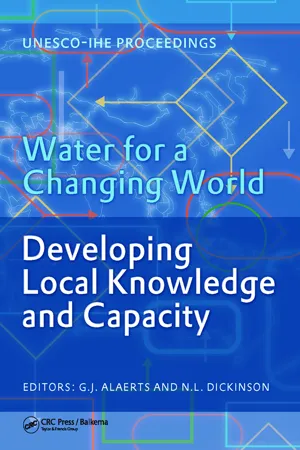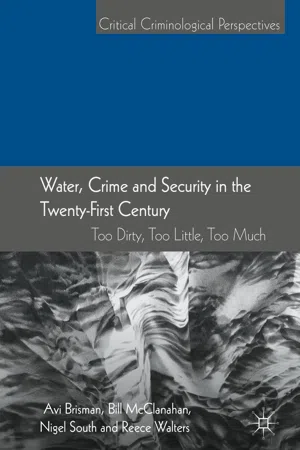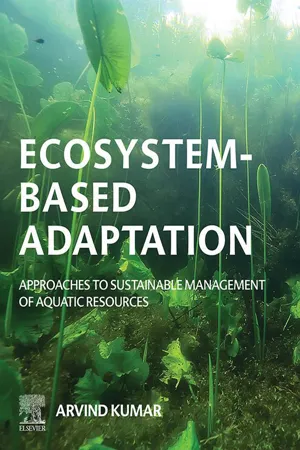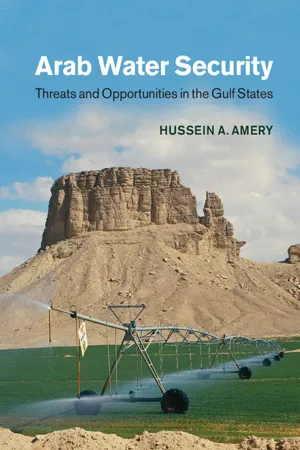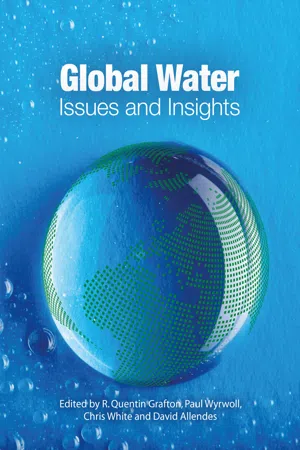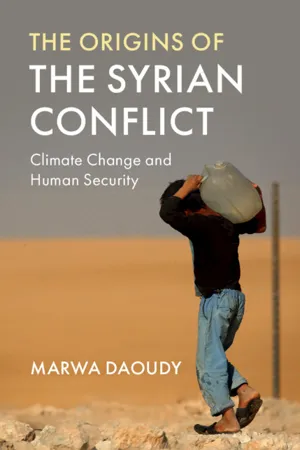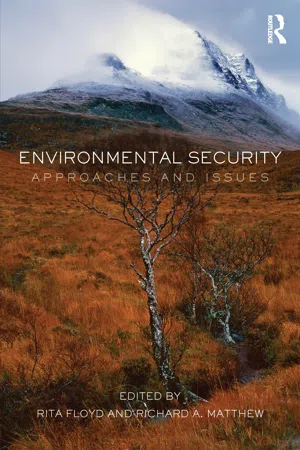Geography
Water Insecurity
Water insecurity refers to the lack of reliable access to clean and safe water for drinking, sanitation, and other daily needs. It encompasses issues such as water scarcity, pollution, and inadequate infrastructure. Water insecurity can have significant social, economic, and environmental impacts, particularly in regions where water resources are limited or under pressure from factors like climate change and population growth.
Written by Perlego with AI-assistance
Related key terms
1 of 5
12 Key excerpts on "Water Insecurity"
- eBook - PDF
Beyond Scarcity
Water Security in the Middle East and North Africa
- World Bank(Author)
- 2018(Publication Date)
- World Bank(Publisher)
7 CHAPTER 1 Why Water Security Matters Water Insecurity threatens global prosperity. It acts as a drag on growth that can cost the global economy some $500 billion per year. The drag is strongest in countries already experiencing water stress, and those with low incomes and high dependence on agriculture (Sadoff et al. 2015). Roughly one-quarter of global GDP is produced in areas with high or very high water scarcity. 1 About 35 percent of the world’s population lives in water-scarce areas, 2 and water-related diseases affect more than 1.5 billion people annually (UNICEF and WHO 2015). Increasing awareness of the impacts of Water Insecurity on human well-being and economic prosperity is reflected in the Word Economic Forum’s Global Risks report, where water-related risks have been consistently ranked among the top 10 global risks (WEF 2015). Water security is a state in which water is effectively and sustainably managed, both to leverage its productive potential and to mitigate its destructive potential. Water security has been defined as “the availability of an acceptable quantity and quality of water for health, livelihoods, ecosystems and production, coupled with an acceptable level of water-related risks to people, environments and economies” (Grey and Sadoff 2007). This definition and others (see, for instance, Grey et al. 2013; Hall and Borgomeo 2013) highlight the importance of risk management in the construct of water security. More recently, UN-Water developed a defi-nition of water security that explicitly captures interactions with wider social, economic, political, and environmental systems, as “the capacity of a population to safeguard sustainable access to adequate quantities of acceptable quality water for sustaining livelihoods, human well-being, and socio-economic development, for ensuring protection against Water Security - eBook - PDF
Water for a Changing World - Developing Local Knowledge and Capacity
Proceedings of the International Symposium "Water for a Changing World Developing Local Knowledge and Capacity", Delft, The Netherlands, June 13-15, 2007
- Guy Alaerts, Nicolas Dickinson, Guy Alaerts, Nicolas Dickinson(Authors)
- 2008(Publication Date)
- CRC Press(Publisher)
Water security also has to be looked at from a time perspective, to secure or enable improvement of livelihoods, to ensure a healthy living environment and to enable a sustainable social and economic development for present and future generations. Peoples need to face the main water security challenges of this era: population growth; economic develop-ment; resource degradation and climate change. Taking all these factors into account allows us to establish a more precise defini-tion of water security: “Water security is the availability of an acceptable quantity and quality of water under changing circumstances for basic human needs, liveli-hoods, ecosystems and production, and the protection against negative impacts from excess water coupled with an acceptable level of water-related risks to people, envi-ronments and economies for the present and future generations”. 2 CAPACITY DIMENSIONS OF (LOCAL) WATER SECURITY Water security is not only about the availability of water as a resource. It is also about the availability of infrastructure to harness the resource and provide the water serv-ices, and the capability to manage and maintain this infrastructure. Reliable service delivery depends on the serviceability and robustness of facilities and the finan-cial, technical and human capability of service organizations to operate and maintain them. Many of the actual water security problems are due to a lack of the right mix of human resources, financial resources and incentives to properly operate, maintain and repair service infrastructure, be it for water supply, irrigation, flood protection, pollution control, or environmental purposes. Water security also involves the protection of water sources from water related hazards. This protection depends on political factors, cooperation within national and trans-boundary basins and aquifers, and the level of peace and stability in a region. - eBook - ePub
Water, Crime and Security in the Twenty-First Century
Too Dirty, Too Little, Too Much
- Avi Brisman, Bill McClanahan, Nigel South, Reece Walters(Authors)
- 2018(Publication Date)
- Palgrave Macmillan(Publisher)
against which threats? From international and external enemies? How much security? Security at what costs?Rather than end with these questions, we wish to remind readers that water is vital for human health and successful ecosystem function (see Galway 2016 ). As this chapter has attempted to demonstrate, the inaccessibility, unavailability and inequitable distribution of water can pose a range of macro- and micro-level problems, and a great deal of interdisciplinary research can be conducted on the correlations between scarcity and insecurity and crime, conflict and violence. Nation-states have a fundamental role in ensuring that the people they serve are adequately supplied with water, but as this chapter has suggested, we have to be vigilant about their methods and motives.Dr James S. Famiglietti, a hydrologist at the University of California-Irvine, prompts us to recall that, ‘[w]ater doesn’t know political boundaries. People have to work together’ (quoted in Hammer 2013 : 18). Along these lines, Gidon Bromberg, the Israeli co-director of Friends of the Earth Middle East, states, ‘[t]here are few major sources of water that don’t cross one or more political boundaries… That creates a natural interdependence between countries’ (quoted in Belt 2010 : 159). Indeed, Butts and Bankus (2013 : 145) have noted that ‘among India and its two Muslim neighbors, Bangladesh and Pakistan, water has served as a confidence-building tool, as the countries have learned to co-operate over the Ganges and Indus rivers’. Of course, water does do not always inspire harmony (see, e.g., Biello 2017 ; Elliott 2014 ), but as Amster (2015 - eBook - ePub
Ecosystem-Based Adaptation
Approaches to Sustainable Management of Aquatic Resources
- Arvind Kumar(Author)
- 2022(Publication Date)
- Elsevier Science(Publisher)
Chapter 5Toward water security
Abstract
Water is a finite resource and though 71% of the Earth is surrounded by water; nevertheless, only 2.5% is freshwater that is used for human consumption, agriculture, domestic, and industrial use. Burgeoning population and the resultant enhanced requirements of increased supply of freshwater for increased food production, industrial, and economic activities along with other socioeconomic requirements have exerted increased pressures on water resources that are being finite are getting depleted in the wake of rapid pace of depletion of groundwater resources, pollution of surface water resources, and speedier melting of glaciers in the wake of vagaries of climate change, thereby triggering water scarcity or Water Insecurity. While focusing on the status of water in the wake of climate change and water scarcity, emphasis is also accorded on nature-based solutions, specifically ecosystem-based adaptation to ensure water security.Keywords
Water security; water scarcity; water quality; climate change; nature-based solutions; ecosystem-based adaptation5.1 Introduction
Water, a finite source, is the most essential element for the survival of human and other biotic organisms, after air. Sustainable supply of water constitutes the bedrock of almost essential necessities of human survival such as food, energy, human health, agriculture, industry, etc., along with socioeconomic and cultural development. Owing to its pivotal role in economic development, the development and management of water resources is “chronologically locked” with the development of the “modern nation-state” (Jeffrey & Gearey, 2006). Water lies at the core of the three pillars of sustainable development – economic, social and environmental. Water resources and the essential services rendered by these resources are among the keys to attaining ambitious goals of poverty alleviation, inclusive growth, public health, food security, lives of dignity for all, along with enduring harmony with earth’s basic ecosystems. Salience garnered by water issues globally in recent years seem to have proved instrumental in demonstrating increasing understanding of water’s centrality as reflected in the millennium development goal (MDG) target of halving the proportion of people without sustainable access to safe drinking water between 1990 and 2010; and this period witnessed about 2.3 billion people gaining access to improved drinking-water sources like piped supplies and protected wells (WWAP, 2015 - Bjorn-Oliver Magsig, Bjørn-Oliver Magsig(Authors)
- 2015(Publication Date)
- Routledge(Publisher)
While a definition is generally regarded as most useful to policy makers when it presents a single and precise interpretation, experts should avoid oversimplification in cases as complex and multi-layered as water security. 118 Here, the interlinkages between different layers and other crises are consistently being overlooked, despite the fact that sustainable freshwater management is strengthening a whole web of securities. For instance, a situation of acute water scarcity (caused by drought or mismanagement) in a developing country which is highly dependent on agriculture would certainly compromise human security (increasing poverty and affecting health), food security (domestic and, potentially, of food-importing countries), economic security (decrease in (not only) agricultural output), energy security (diminishing availability of water for production of electricity) and environmental security (putting ecosystems under stress and causing biodiversity loss) – at the local, regional and international level. Hence, an unambiguous definition, applicable to each and every instance of Water Insecurity, is simply elusive, and thus cannot be a prerequisite for tackling the world water crisis. What is needed, however, is a common understanding of what water security means and, even more importantly, how we should move ahead in order to prevent the crisis getting out of hand. This is why the following definition of water security is proposed here: A community is water secure when it has sustainable access to freshwater of sufficient quantity and quality, or to the benefits derived therefrom, and the ability to minimise water-related risk and its various repercussions to an acceptable level – without compromising the supporting ecosystems. This definition draws from both the widening and deepening process of the general security debate; while, at the same time, acknowledging the complexity of the water crisis- eBook - PDF
Arab Water Security
Threats and Opportunities in the Gulf States
- Hussein A. Amery(Author)
- 2015(Publication Date)
- Cambridge University Press(Publisher)
4 Responses to Water Insecurity 4.1 Introduction The current global water crisis is largely a result of “profound failures in water governance, i.e., the ways in which individuals and societies have assigned value to, made decisions about, and managed the water resources available to them” (UNDP 2004, p. 2). Some 80 percent of “the world’s population is exposed to high levels of threat to water security”, a challenge that concerns arid as well as non-arid countries. The same study argues that “massive investment in water technology enables rich nations to offset high stressor levels without remedying their underlying causes, whereas less wealthy nations remain vulnerable” (Vörösmarty et al., 2010, p. 555). Margaret Catley-Carlson of the World Economic Forum stated that new, innovative approaches to water management need to be developed in the next two decades otherwise, “large parts of the world will face a serious and structural threat to economic growth, human well-being, and national security. Some will feel the heat sooner than others” (WEF, 2011, p. xxii). Technological innovations such as desalination are inevitable for those countries and regions that are arid and wealthy enough to afford them. In addition to economic tools, technological and softer, non- technical measures such as education need to be deployed in sync to help develop cultural norms that value freshwater resources and encourage residents to act on and pay for their protection, provision, and sustainable management. Freshwater availability in the Gulf states is an order of magnitude lower than demand has been in recent decades. It takes one liter of freshwater to produce one calorie of food, hence each person needs an average of 2,800 liters of water a day in order to live a healthy and hygienic life. - eBook - PDF
Water
Global Common and Global Problems
- V I Grover(Author)
- 2016(Publication Date)
- CRC Press(Publisher)
Since water- scarce regions of water-stressed countries already suffer most from undernourishment and poverty these are areas most needing to be served and still least served. In other words, the problem is not simply one of water resource supply—it is equally about accessibility to supplies, appropriate usage once accessed, and the management of hazards that may impinge on all three. ‘More Water’ is Not Enough If household water security is defined as ‘access by all individuals at all times to sufficient, safe water for a healthy and productive life and sustainable livelihood’, then the concept incorporates elements relating not only to water supply but also access, water quality (minimum thresholds of purity or absence of contaminants/pollutants), and the minimization of water-related risks to health and livelihoods. These elements can be grouped under three main headings: Availability, Access, and Usage. For example, water availability is a function of supply, largely dependent on ecological factors, some of which can be degraded or enhanced by human action, and distribution (the mechanisms by which water is made useful to human (and ecosystem) activities). Water access refers to household control of a commodity. This is partly determined by modes of distribution (national policies and investment priorities play important roles here), and partly by effective demand; that is, how much a household can actually ‘take home’ (to kitchen, farm or trough). The latter depends on income, location (in relation to distribution channels), and sometimes on status. Water usage relates to individual entitlements, i.e. water as a public and private good. Physiological absorption depends on quantity of water consumed, its quality (safety), perceived entitlements, environmental constraints (non- water-borne diseases), opportunity costs, and knowledge (human capital formation in relation to hygiene, sanitation, consumption, and disease control). - eBook - PDF
Global Water
Issues and Insights
- R Quentin Grafton, Paul Wyrwoll, Chris White, David Allendes(Authors)
- 2014(Publication Date)
- ANU Press(Publisher)
The existence of several definitions of water scarcity (he explores four), and indeed the different measures to capture aspects of it, can result in varied, sometimes contradictory, findings in relation to a region’s water stress. It is, therefore, important to understand which definition is ‘fit for purpose’, and to avoid relying on any single measure. A region’s capacity to employ multiple indices in decision-making will, however, necessarily be constrained by the skills, knowledge, and data available to it, suggesting that even if definitional clarity is achieved, the value of using such concepts remains a direct function of the institutional capacity in that region. One of the most interesting developments in recent years has been the emergence of non-traditional security threats, and in particular the concept of ‘environmental security’ (Dalby 2002). The appeal of ‘securitisation’ as a conceptual frame lies in its realist roots: it is a familiar concept and draws considerable favour with the powers-that-be, not least because security issues are almost always in the purview of national governments. As a consequence, debates about environmental issues are afforded considerably more attention than might otherwise be the case — or so the argument goes. Interestingly, environmental security was very quickly disaggregated into ‘climate security’, ‘energy security’, and ‘water security’, and it is the meaning and practical utility of the latter concept to which Lautze and Manthrithilake (Chapter 29) turn their attention. Specifically, their article is a plea for the concept of ‘water security’ to be defined in such a way as to be practically applied, and their suggestion is to develop some quantifiable criteria against which to evaluate a region’s water security — even though they are openly sceptical about the value of promoting yet another concept in this crowded space. - eBook - PDF
The Origins of the Syrian Conflict
Climate Change and Human Security
- Marwa Daoudy(Author)
- 2020(Publication Date)
- Cambridge University Press(Publisher)
As Simon Dalby argues, vulnerability should be understood as a “complex social and ecological situation” that is related to and works in connection with “social and economic entitlements” of a specific community or context (2013: 128). Vulnerability is a helpful measure for understanding the feedback effects between different types of human insecurity precisely because it forces a focus on specific contexts while also calling to attention the role of larger structural inequalities. For the purposes of this study, vulnerability is defined in terms of disruption to patterns of daily life from the perspective of the margin- alized and dispossessed. Such disruptions to patterns of daily life 18 The Context: History, Geography, Security include chronic Water Insecurity, land degradation, arable land scarcity, food insecurity, and poverty, as well as a combination of inefficient irrigation schemes and relocation plans as a result of irriga- tion projects. The critical environmental security approach adopted by HECS deliberately centers the narrative on individual human lives, making food and Water Insecurity a critical component of understanding how macro political, economic and environmental trends drive individ- ual’s daily access to sustenance. Working in connection with the concept of vulnerability are a series of resilience factors that show how societies and community units respond to and cope with these risks. Wisner et al. (2004: 11) pull these parallel concepts together to define vulnerability as “the characteristics of a person or group and their situation that influ- ence their capacity to anticipate, cope with, resist and recover from the impact of a natural hazard.” In this sense, vulnerability and resilience factors show the relationship between political, economic, climate, and food and Water Insecurity identified by the HECS model. - eBook - PDF
Engineers Engaging Community
Water and Energy
- Carolyn Oldham, Gregory Crebbin, Stephen Dobbs, Andrea Gaynor(Authors)
- 2022(Publication Date)
- Springer(Publisher)
It is anticipated that by 2025, 1.8 billion people will be living in regions of water shortage (or absolute rather than relative scarcity), and two-thirds of the world’s population could be experiencing water stress, a condition approaching shortage (FAO, 2012). At present, many regions are dependent on unsustainable extraction of groundwater (Burke and Moench, 2000). In average years, adequate flows no longer reach the mouths of many rivers, including the Colorado, Nile, and Huang He, with severe consequences for human and non-human communities. More than a quarter of all North American freshwa- ter fauna are now considered threatened, due to extraction of fresh water for economic uses, and transformation of freshwater ecologies (Gleick, 2003). There is also increasing uncertainty, as our capacity to monitor critical aspects of the global water balance is diminished, and anthropogenic climate change introduces a range of new challenges. In this context, “business as usual” is simply not a viable option. U.N. Definition of Water Scarcity There are several ways of defining water scarcity. In general, water scarcity is defined as the point at which the aggregate impact of all users impinges on the supply or quality of water under prevailing institutional arrangements to the extent that the demand by all sectors, including the environment, cannot be satisfied fully. Water scarcity is a relative concept and can occur at any level of supply or demand. Scarcity may be a social construct (a product of affluence, expectations and customary behavior) or the consequence of altered supply patterns—stemming from climate change for example. Scarcity has various causes, most capable of being remedied or alleviated. A society facing water scarcity usually has options. - eBook - ePub
Environmental Security
Approaches and Issues
- Rita Floyd, Richard Matthew, Rita Floyd, Richard Matthew(Authors)
- 2013(Publication Date)
- Routledge(Publisher)
In pioneering work, Sandra Postel identified those countries that rely heavily on irrigation, and whose agricultural water supplies are threatened either by a decline in quality or quantity. The list coincides precisely with regions of the world community’s current security concerns, where instability can have profound effects: India, China, Pakistan, Iran, Uzbekistan, Bangladesh, Iraq, and Egypt. 34 Water management in many countries is also characterised by overlapping and competing responsibilities among government bodies. Disaggregated decision making often produces divergent management approaches that serve contradictory objectives and lead to competing claims from different sectors. Such claims are most likely to contribute to disputes in countries where there is no formal system of water-use permits, or where enforcement and monitoring are inadequate. Controversy also often arises when management decisions are formulated without sufficient participation by local communities and water users, thus failing to take into account local rights and practices. Protests are especially likely when the public suspects that water allocations are diverting public resources for private gain or when water use rights are assigned in a secretive and possibly corrupt manner, as demonstrated by the violent confrontations in 2000 following the privatization of Cochabamba, Bolivia’s water utility. 35 Intra-state water conflicts The second set of security issues occur at the sub-national level. Indeed, if there is a history of water-related violence, and there is, it is a history of incidents at the sub-national level, generally between tribes, water-use sectors, or states’ provinces - eBook - PDF
Divided Environments
An International Political Ecology of Climate Change, Water and Security
- Jan Selby, Gabrielle Daoust, Clemens Hoffmann(Authors)
- 2022(Publication Date)
- Cambridge University Press(Publisher)
2 Geography versus Demography The Question of Scarcity No idea is more central to mainstream water, climate and environmental security discourse than the idea of ‘scarcity’. Scarcity, it is typically assumed, leads to competition, marginalisation, migration, insecurity and conflict, and in an era of accelerating climate change will likely do so with ever wider and more acute consequences. Such is the basic premise under- pinning most environmental security thinking, whether the word ‘scarcity’ is deployed or not. Thus Thomas Homer-Dixon’s major explanatory claim on the subject is that ‘environmental scarcity causes violent conflict’. Michael Klare maintains that global limits on freshwater availability com- bined with rising demand will, by 2050, produce ‘intense competition for this essential substance in all but a few well-watered areas of the planet’. The Environmental Justice Foundation foresees a world of ‘scarce futures’. Margaret Beckett, as UK foreign secretary, claimed that ‘[w]hen people are exposed to the stresses caused by overpopulation, resource scarcity, environmental degradation, as they feel the security upon which they and their families depend progressively slipping away, so we see the slide down the spectrum from stability to instability’. And the first major defence planning study of climate security risks put the issue thus: Abrupt climate change is likely to stretch carrying capacity well beyond its already precarious limits. And there’s a natural tendency or need for carrying capacity to become realigned. As abrupt climate change lowers the world’s carrying capacity aggressive wars are likely to be fought over food, water, and energy. Deaths from war as well as starvation and disease will decrease population size, which overtime, will re-balance with carrying capacity. 1 1 Homer-Dixon, ‘Environmental scarcities’, 39; Homer-Dixon, Environment, Scarcity and Violence, 93; M.
Index pages curate the most relevant extracts from our library of academic textbooks. They’ve been created using an in-house natural language model (NLM), each adding context and meaning to key research topics.

